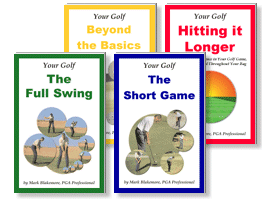Overswinging
Causes and Cures
by Mark Blakemore, PGA Professional
Many golfers have a problem with overswinging, or taking too big a backswing. Overswinging encompasses a lot of different pieces and parts, but is generally thought of in terms of taking the club shaft beyond the point where it is parallel to the
ground at the top of the backswing. The pieces and parts may include too big a body turn, a collapsing lever arm (i.e., severely bending the left elbow for right-handers), cupping or overcocking the wrists, opening the fingers of the lever arm hand,
collapsing or totally straightening the rear leg, a reverse pivot (leaning the spine toward the target with the weight on the forward leg at the top of the swing) and more.
Overswinging is usually a problem because the more moving parts one has and the farther out of position one gets the more difficult it is to bring the club back to the appropriate place at the appropriate time, let alone do it consistently (or even
the same way twice). That being said, if you can perform well and with consistency in spite of an overswing then congratulations on your hand-eye coordination and athletic ability - keep up the good work. There are a few notable supposed
overswingers who are absolutely great -- John Daly, Tom Watson and Nancy Lopez immediately come to mind and I'm sure there are more. I don't think many golfers would argue with their results, and whether or not they would be better without their
overswings is academic. But it is safe to say that you wouldn't want to teach the golf swing that way, as the odds of consistent success for the huge majority of golfers are drastically reduced by overswinging.
Okay, so if we have an overswinging problem what can we do about it? If you check the following areas at the top of the backswing, one-at-a-time, you will discover where the problem occurs and be able to correct it. These things can all be checked by
watching yourself swing in a mirror, and certainly a reputable golf professional or attending a golf school could help you with this problem. (All individuals will not be
physically capable of all these.)
At the top of your backswing check to make sure that
- Both eyes can see the ball (close your eye closest to the target to test this, make sure your open eye never loses sight of the ball)
- Your spine angle is still relatively vertical from the face-on view, definitely not leaning toward the target
- Your weight is noticeably heavier on your rear leg and that your rear knee maintains at least some degree of flexion - also that the knee has not moved to a position, nor points in a direction, outside the foot
- Your lever arm (left arm for right-handers) is relatively extended (not to say tense/rigid) rather than collapsed or severely bent at the elbow
- Your hands and wrists are under control - make sure the fingers of the lever arm hand have not opened and that the butt end of the grip is still in contact with the fleshy "karate chop" pad of the hand. Make sure, also, that the wrist is
not dramatically cupped (back of hand bent back toward top of forearm) - for most people who are not double-jointed the angle between the shaft and the lever arm should not exceed 90 degrees - at least not by much
If those check points are met it is not possible to overswing, or if you can, perhaps you should contact Cirque du Soleil to audition for one of their contortion acts. 

For more help with your game get my 4-volume series of paperback books covering the entire game in detail -- The 'Your Golf' Series.

Find out more about these books
Work on your game with me in person
 To develop good habits you'll need to work with a professional in person. If you'd like to work with me see more details about my golf schools and lessons. If you can't
come to work with me in person try www.PGAPros.com.
To develop good habits you'll need to work with a professional in person. If you'd like to work with me see more details about my golf schools and lessons. If you can't
come to work with me in person try www.PGAPros.com.
|